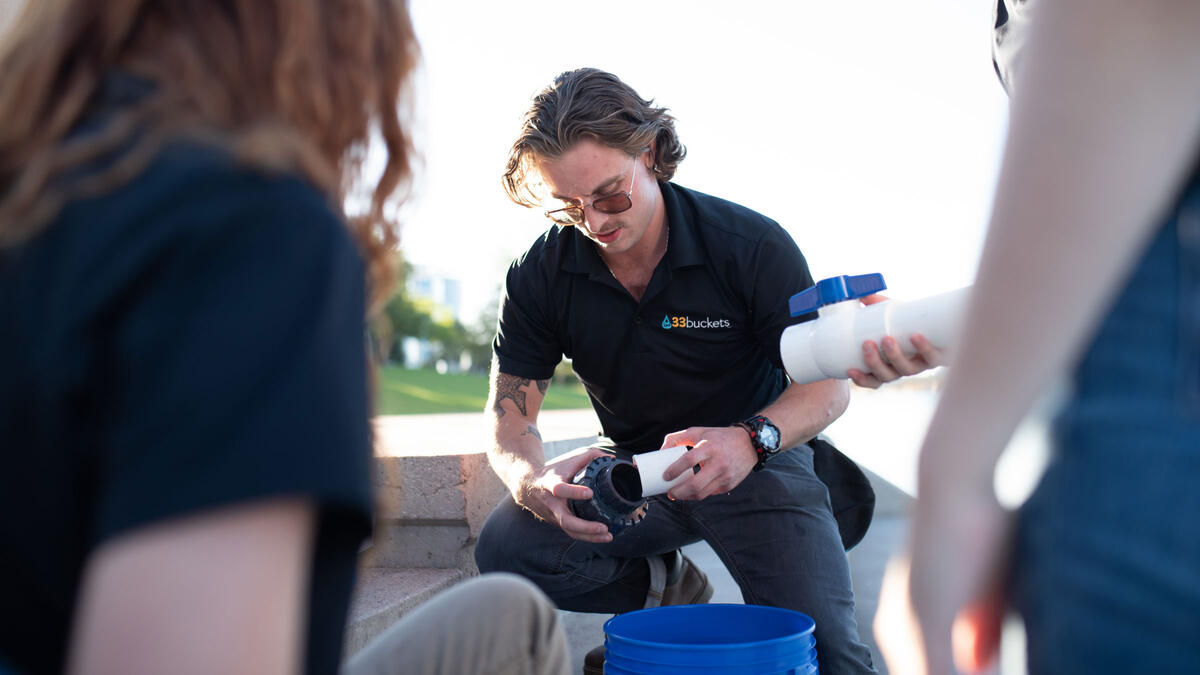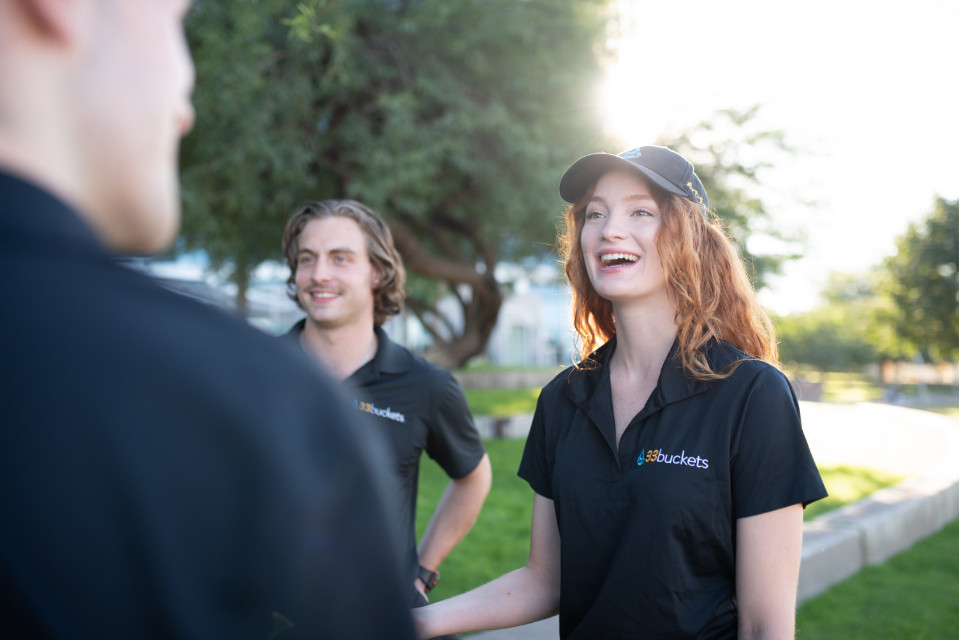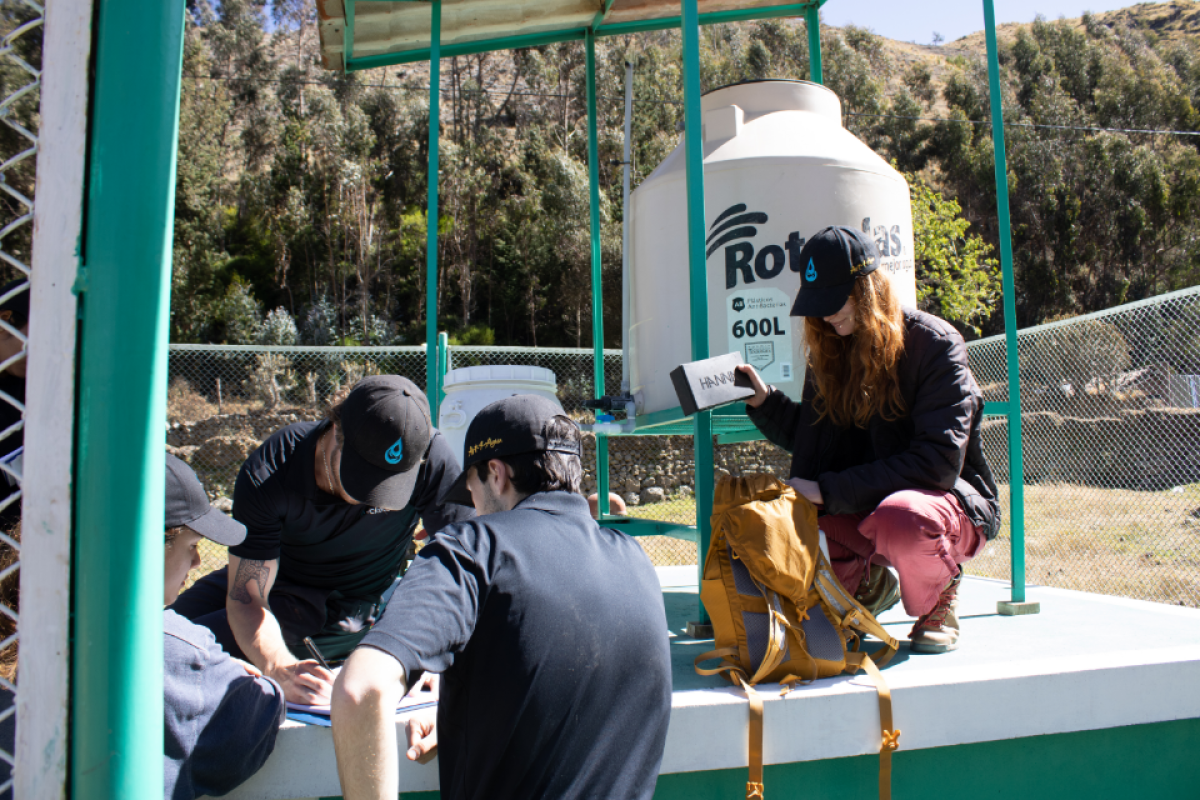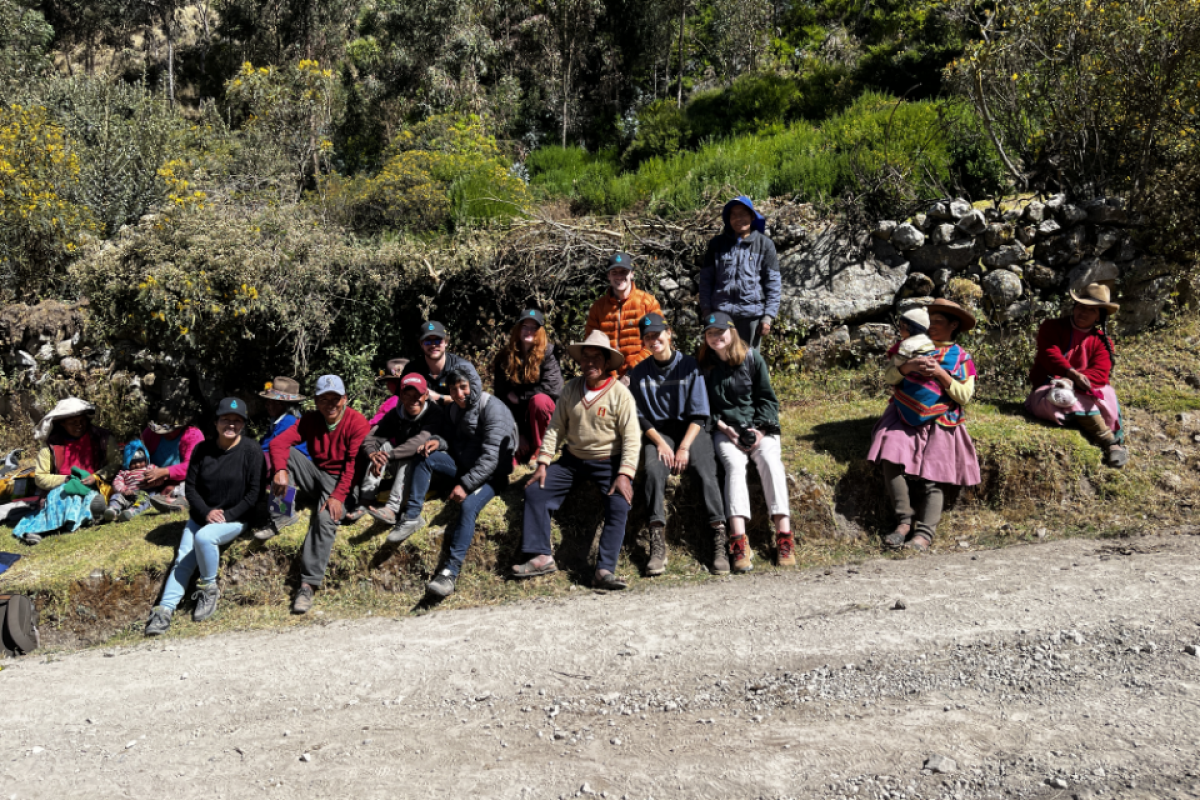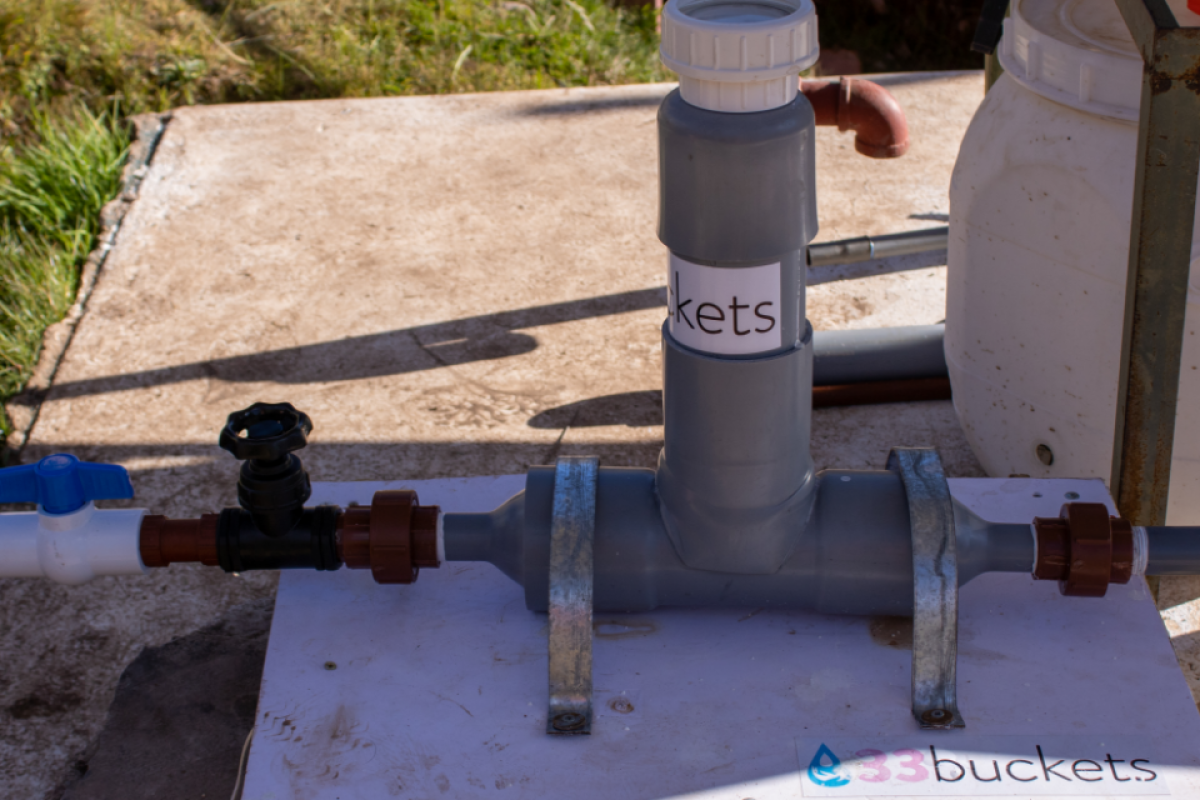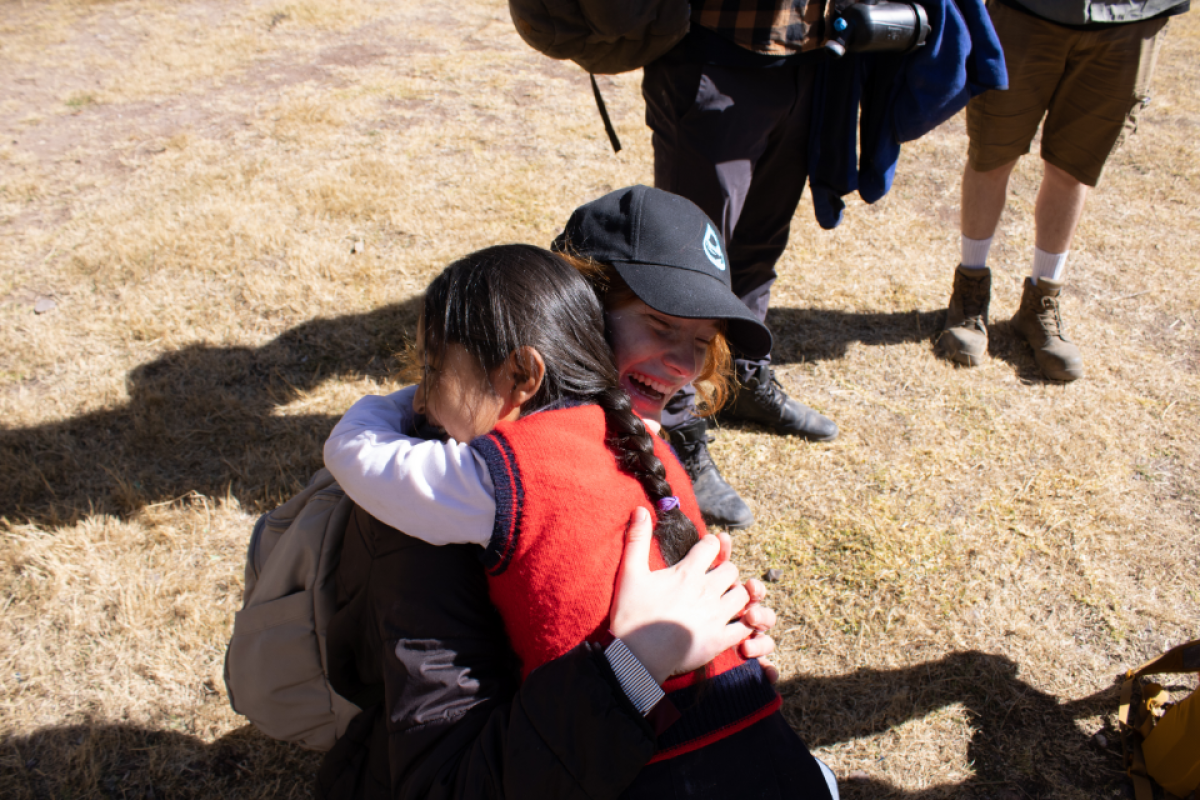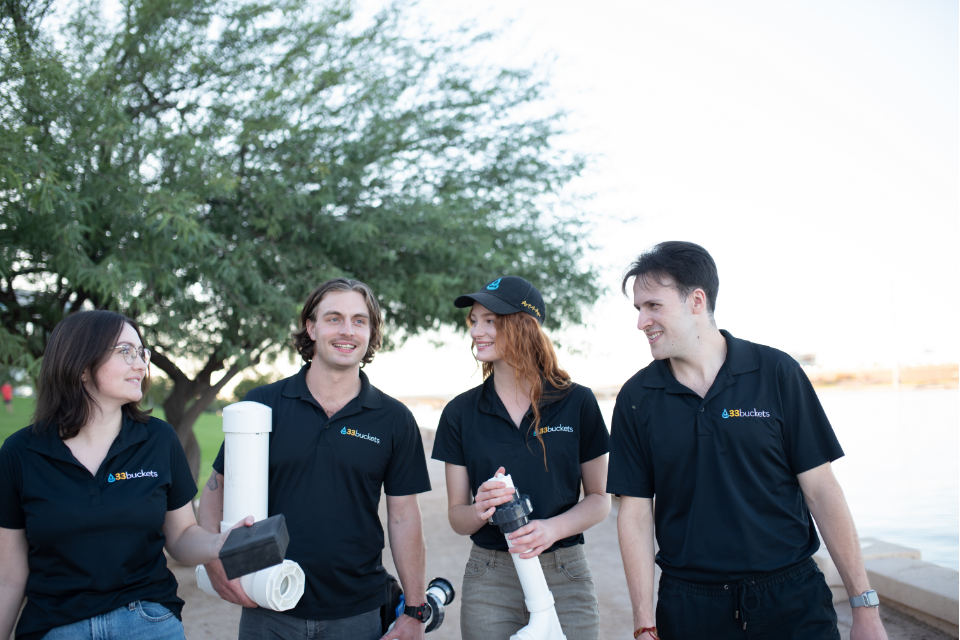Editor's note: This story originally appeared in the winter 2023 issue of ASU Thrive magazine.
Adam Westmoreland stepped out of the vehicle into the dramatic landscape of Peru. And he took a deep breath in the thin air at 10,000 feet in elevation.
For the next three months, he and other student interns for the nonprofit 33 Buckets would collaborate with the people of Cusco, Peru, to improve water treatment setups. The nonprofit partners with small, rural communities to engineer a customized plan for access to clean water.
In 2015, three then-ASU students started 33 Buckets: Mark Huerta, ’13 BS and ’15 MS in bioengineering, ’19 PhD in engineering education; Swaroon Sridhar, ’17 BS in bioengineering; and Paul Strong, ’13 BS and ’14 MS in mechanical engineering, ’18 MBA.
Now directed by a different mix of alums with the help of ASU students and Engineering Projects in Community Service, the nonprofit continues to help address clean-water access issues in Peru in collaboration with local communities.
The collaborator: Erin Burgard
When Erin Burgard was 14, she attended a summer camp at the Barrett Summer Scholars program and heard Huerta talk about 33 Buckets’ work.
“I had no idea what I wanted to do with my life before listening to Mark talk,” Burgard says. “I remember feeling passionate about how they worked side by side with communities to make change.”
Seven years later, Burgard, now an environmental engineering junior at Barrett, The Honors College, was the 33 Buckets aquaculture project and development intern on the ground in Cusco this past summer. It was a role she prepared for throughout the 2021–22 school year ahead of the trip.
Burgard says she came away with a new awareness of what it takes to create long-term sustainable water infrastructure.
“It takes a lot of collaboration,” Burgard says. “It takes mayors to accept the project, water managers to agree to meet, people to coordinate transportation, translators to help with Indigenous languages, time, planning and faith that it will all work out.”
Burgard says a typical day in her life as an intern was the team working on their laptops at a local restaurant going over interviews with the community, setting up new meetings and creating outlines for future interviews. She and the interns also conducted technical assessments on systems, such as residual chlorine levels, flow rate and reservoir measurement.
How did she use her engineering skills? “I took data samples of the chlorine levels by filling a test tube with the water, adding a reactant and putting it into a chlorine checker and forming conclusions about how to proceed to further the system’s success,” Burgard explains.
It’s the memories of the people and the places that most stick with her.
“One of my best experiences was working in the community; a family would serve us a lunch of potatoes while we sat on a bench in their backyard in the middle of the Andes Mountains,” she says. “Everything in Peru is very colorful — the woven work, jewelry, clothing and even the Cusco flag is rainbow. The city of Cusco is like a maze with cobblestone streets and walls made of large rocks. It often smelled like burning palo santo wood and a classic Peruvian taste jugo de maracuyá, which is passion fruit juice.
“But something that influenced my thoughts when I was in Peru was how much the communities expressed gratitude for us being there. You can’t know who will remember the information you gave them, but maybe one person will remember and decide to become an environmental engineer, get a degree and come back to the community to continue the process and make change.”
She also understands now what solutions in collaboration with the community mean: “The idea that you can’t build anything lasting until you understand the impact of those changes on the community. It has to be something they can manage without an organization when you leave,” she says.
Enviornment engineering students Daniel Hoop and Erin Burgard. Photo by Courtney Lively, ’07 BIS in interdisciplinary studies
The director: Daniel Hoop
Daniel Hoop, ’20 BS in environmental engineering, has been involved with 33 Buckets since 2017, first as a student intern through ASU’s EPICS program. He’s now the 33 Buckets executive director and says each community they work with is unique, and communities in a shared region like Cusco often face similar issues in scope.
“The contaminant of concern in many of these communities is Escherichia coli, more commonly referred to as E. coli. It’s the primary bacteria that chlorine treatment systems address,” Hoop says.
Hoop says they most commonly see communitywide chlorine drip systems. For communities without clean water systems, 33 Buckets helps them set them up. For others, the nonprofit helps improve the current system to make the water taste better and the design work better with less maintenance. And for yet others, Hoop says that 33 Buckets has developed a novel system called Sistema de Cloro Peruano.
But first, the team listens to the community through formal interviews to hear about challenges, limitations and needs, which is fundamental to human-centered design.
The humanist: Adam Westmoreland
In the summer of 2021, Westmoreland, now a chemical engineering junior at Barrett, The Honors College, traveled to Peru under pandemic conditions with Hoop. During his first trip, he focused on physically prototyping a new water treatment system, known as SICLOP, versus improving the existing chlorine disinfection system.
“The SICLOP addresses shortcomings of the previously used chlorine drip systems,” Westmoreland explains. “It has a much lower demand for adjustments to maintain consistency and automatic response to different water flow rates into the community’s reservoir to match the amount of chlorine needed for disinfection.”
In the summer of 2022, Westmoreland continued his work from that village and processed data from SICLOP to ensure it was still effective. He also began assessments with other communities.
Westmoreland says he felt prepared for his work in Peru despite not knowing what that work would be. Through ASU’s community service course, he learned the process of human-centered design. “The first step in this process is to gather key insight from stakeholders. And that is what I did during my first summer in Peru.
“My first day, we were taking community assessments of a community in the Cusco region called Totora to understand better what was and wasn’t working with the communitywide chlorine drip system,” Westmoreland explains. “This feedback shaped our work on the prototype, and that feedback guided the requirements we held ourselves to as we designed the system. Once we agreed on a suitable design, I was part of the physical construction of the system, which only took about three days between securing necessary parts and putting it all together.”
Westmoreland says his 33 Buckets experience profoundly changed him. The most significant change that stands out for him after two trips to Peru is how much more open he has become. “The power of working very closely with those you are trying to help and serve greatly impacts you.”
Pragmatically, Westmoreland says 33 Buckets does a great job listening to people’s needs.
“The main job of the people in these communities is agricultural work. They don’t get paid to manage the water system; it is all voluntary,” Westmoreland explains. “The priority for any new water treatment system (there) needs passive management where possible with the least amount of adjustments made to the system per day, week or month.”
The advocate: Risa Fish
Risa Fish is a senior at Barrett, The Honors College. She is working on her public service and public policy degree in sustainability. Her thesis, “The Integration of Human-Centered Design into Policy Systems to Create Long-Lasting Sustainable Change,” grew from her time with 33 Buckets on the ground at ASU and in Peru.
She didn’t start that way. “I’ve always been interested in sustainability, but I changed my major five times, including a shift from political science and law, before I ended up where I am today,” Fish says.
Fish is one of the 33 Buckets interns who is not an engineering student, as the nonprofit also relies on marketing and fundraising in addition to engineering and chemistry. Fish worked with 33 Buckets as a social media intern, starting first through a remote internship on campus during the pandemic in 2020. Fish had previously worked on social media campaigns, but none with a mission like 33 Buckets.
“On the ground in Peru, I focused on getting to know the people and to see how they would interact with us and each other so that I could better understand them and the importance of the work we were doing,” Fish says. “Getting the opportunity to sit with the community members, even with the language barrier, I could tell how compassionate they all are and how much they care for the people in their community.”
Fish says that process gave her a chance to understand the mission better. “I needed to use that experience to promote 33 Buckets and be a global advocate for water policy and sustainability.”
Fish was in Peru for three weeks. “We arrived there at night, so it was interesting to see the lights flying into Cusco — the city of Cusco is set up to look like a puma, which is a spiritual animal for them,” Fish says.
“One of the days I felt the most hands-on was on our visit to Totora when we had the opportunity to host a WASH [water, sanitation and hygiene] education seminar for the children in the community,” Fish says.
Fish says she realized they were educating the future leaders of this community and carving a path for them to one day take over as the water managers of their communities. “This made me feel very thankful and lucky to be there working with people, and it made me realize that we are making an impact at all levels of the community.”
One of Fish’s biggest surprises was how appreciative and willing the community was to work with them. “They have so much compassion for people inside and outside their community,” Fish says. “Before I went to Peru, I said the words I needed to say to advocate for clean water. But after working in the communities and seeing the engineering work we did, I felt the words I was saying. It changes the course of their lives to have easy access to clean water.”
Student intern Risa Fish, Executive Director Daniel Hoop, and student interns Erin Burgard and Adam Westmoreland. They spent the summer helping communities in Peru build safe water systems. Photo by Courtney Lively, ’07 BIS in interdisciplinary studies
Continuing to help
With 5 million Peruvian citizens lacking clean drinking water, improving access continues to be 33 Buckets’ mission. The experiences created through the nonprofit are invaluable both for communities and for the numerous students involved over the years, Hoop says. Students get to take the wide-angle view to explore what’s out there and what’s possible.
“Trying to answer questions like how can I do something meaningful? Or how can complex, expensive solutions be available in rural, impoverished areas? And questions like what should the future look like and how do we get there — and putting those solutions into practice is the best way to articulate why I work with 33 Buckets,” Hoop says.
Get involved
Learn more about 33 Buckets at 33buckets.org or facebook.com/33Buckets.
Story by Jennifer Kite-Powell, a senior technology contributor at Forbes.com. She was named one of the top 100 women in technology in Europe in 2012, and shortlisted for best tech journalist by the TechCrunch Europas Awards.
Top photo: Daniel Hoop has been involved with 33 Buckets since 2017 when he was a student. He's now executive director of the nonprofit that has helped 15 communities build clean water systems. Photo by Courtney Lively, ’07 BIS in interdisciplinary studies
More Science and technology
2 ASU faculty elected as fellows to National Academy of Inventors
Arizona State University faculty members Bertram Jacobs and Klaus Lackner have been elected as fellows to the National Academy of Inventors (NAI). Both are being honored for research that…

Harvesting satellite insights for Maui County farmers
Food sovereignty can refer to having access to culturally significant foods, but Noa Kekuewa Lincoln believes it goes farther than that.“I think the concept goes beyond the foods themselves to having…

Google grant creates AI research paths for underserved students
Top tech companies like Google say they are eager to encourage women and members of historically underrepresented groups to consider careers in computer science research.The dawn of the era of…
